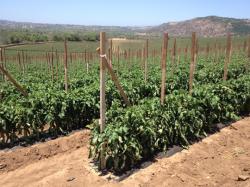Oceanside Pole Vine-Ripe Tomato Harvest Underway
July 9, 2013 | 2 min to read

OCEANSIDE, Calif. — The legendary Oceanside Pole vine-ripes are back, and in a big way.
With increased volume thanks to added acreage and enhanced seed selection, West Coast Tomato Growers, owners of the famed Oceanside Pole tomato brand, are poised for an excellent season.
Harvest began on the final days of June, and will continue through autumn.
“Growing conditions have been ideal throughout the last few months,” said Aaron Quon, director of The Oppenheimer Group’s greenhouse and vegetable categories. Oppy is the exclusive marketer of the Oceanside Pole and Cal-Tom tomato labels grown by Harry Singh Jr. in Oceanside. “We made a few adjustments in the off season which we believe will enhance our customers’ experience even further. We’re really quite proud to bring these tomatoes to market knowing the effort and expertise that has gone into their productionand having tasted the result.
“This spring, Mr. Singh planted the signature seed varieties that have made Oceanside Pole vine-ripe tomatoes one of the best labels in the industry,” Quon explained. “The original seed will enhance overall yield, quality, and flavor, and, importantly, shelf-life. Retailers located across the country can choose Oceanside with confidence.”
In addition, Oceanside Pole fans can look forward not only to Mr. Singh’s legendary vine-ripened tomatoes, but also to Roma tomatoes grown with the same expertise in the same ideal coastal environment.
“Customers will be able to load rounds and Romas on the same truck, improving shipping efficiency,” Quon said. Romas will be available in early August.
Tomatoes grown in Oceanside enjoy the benefits of the warm coastal mountainous microclimate, along with the pole technology used to produce them, which keeps the tomatoes off the ground and in pristine condition, lending to greater flavor and shelf life. After harvest, the tomatoes are sorted by color and place-packed by hand on the same day.
Oppy also markets conventional greenhouse tomatoes from the U.S., Canada and Mexico and organic greenhouse tomatoes grown in Canada and Mexico.
Source: Oppy | The Oppenheimer Group
